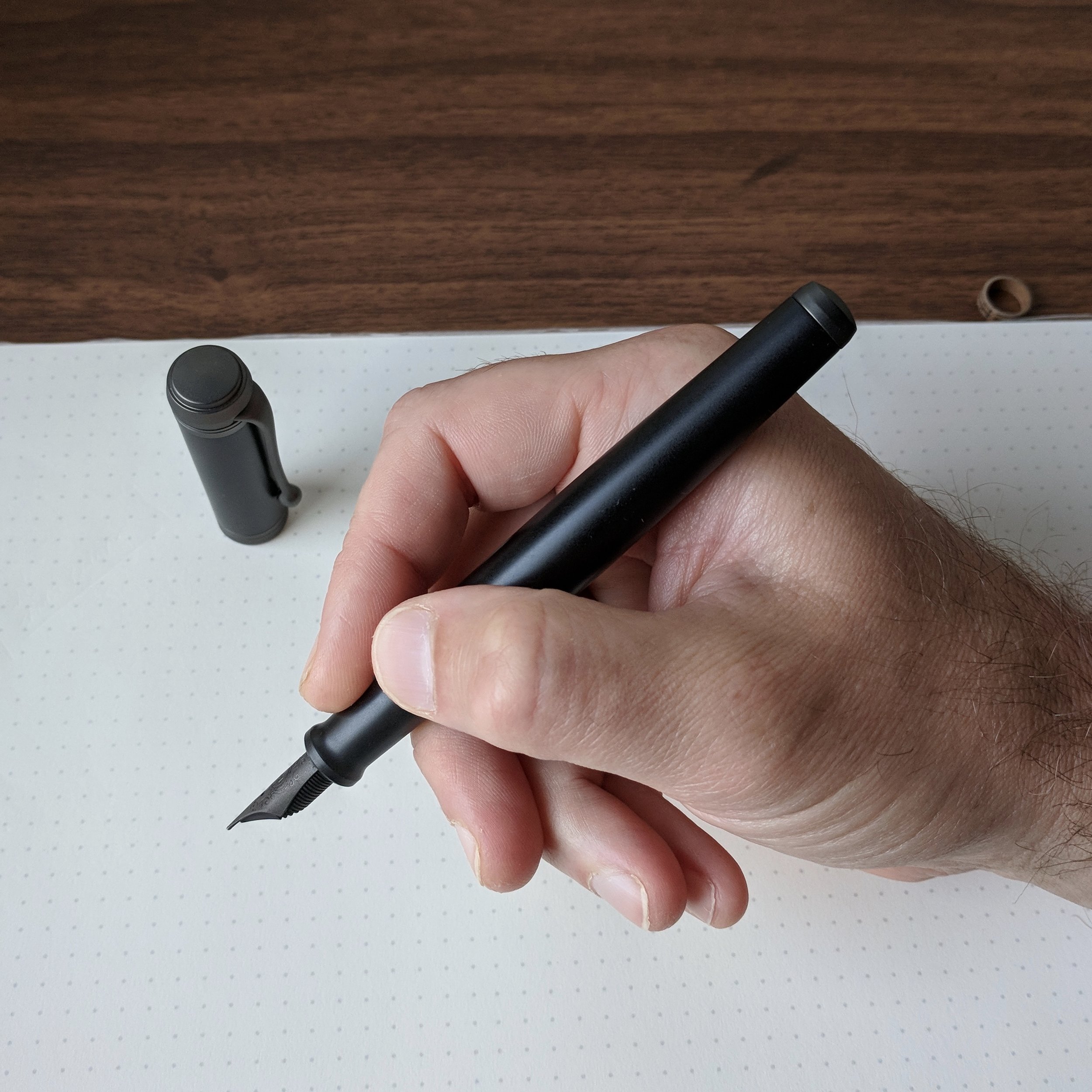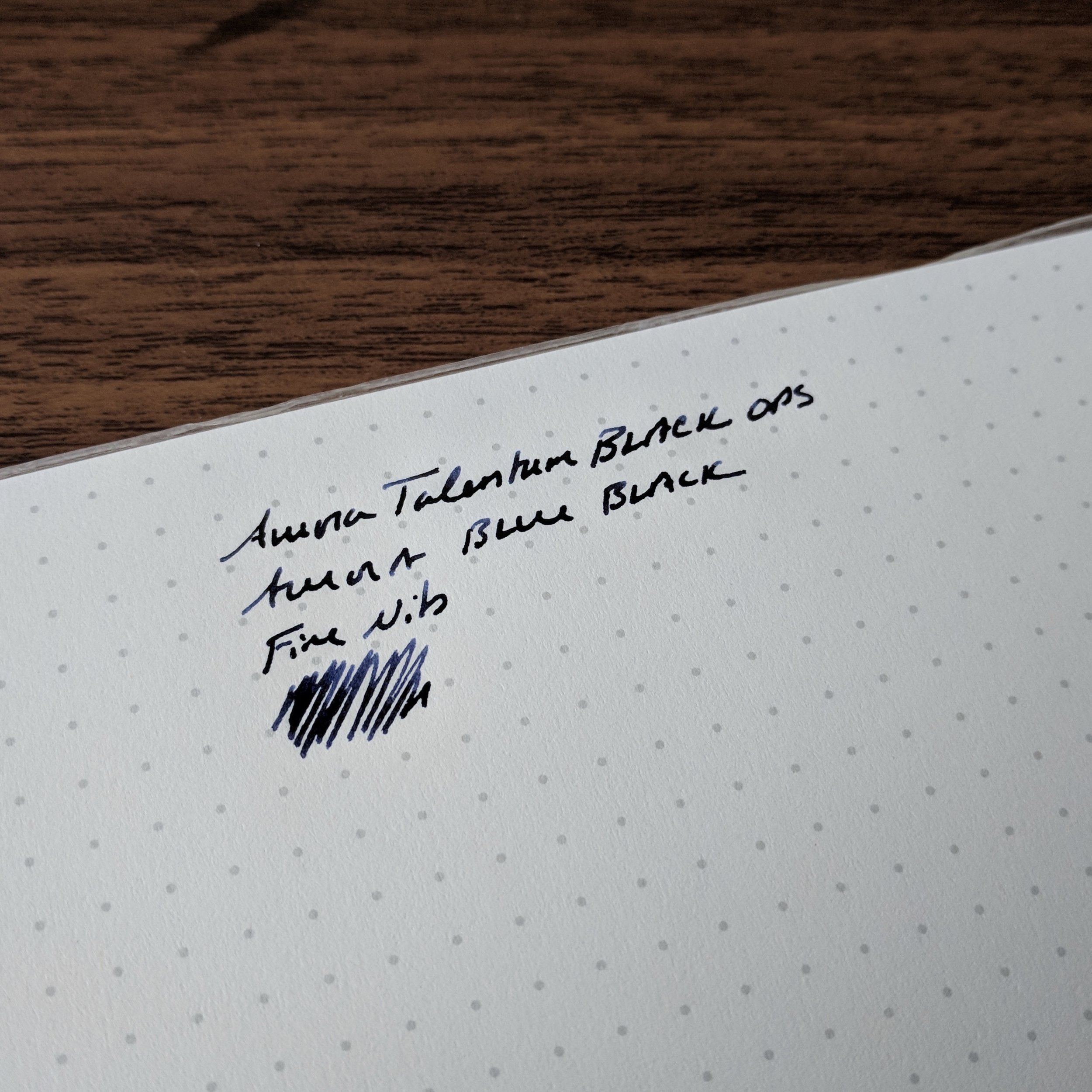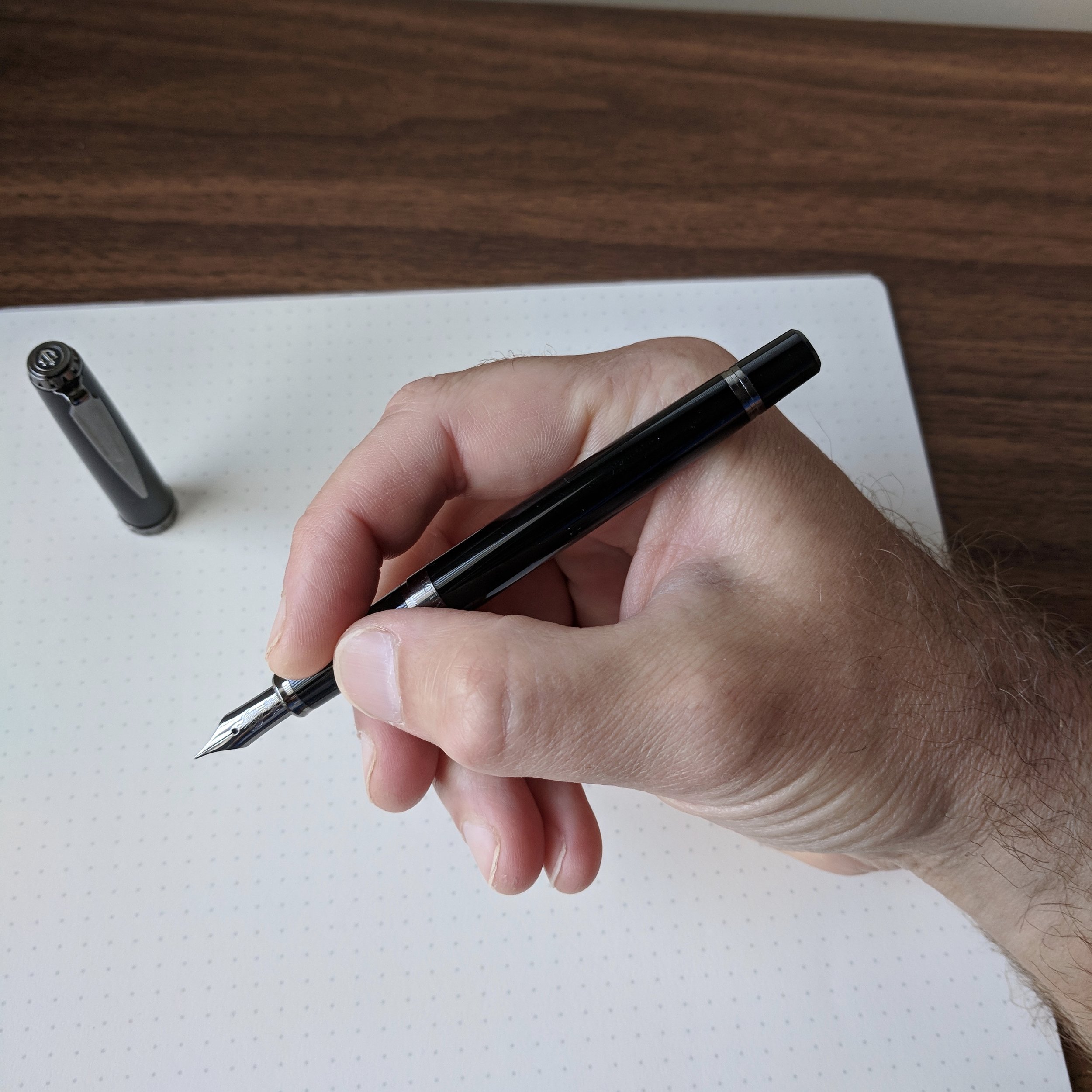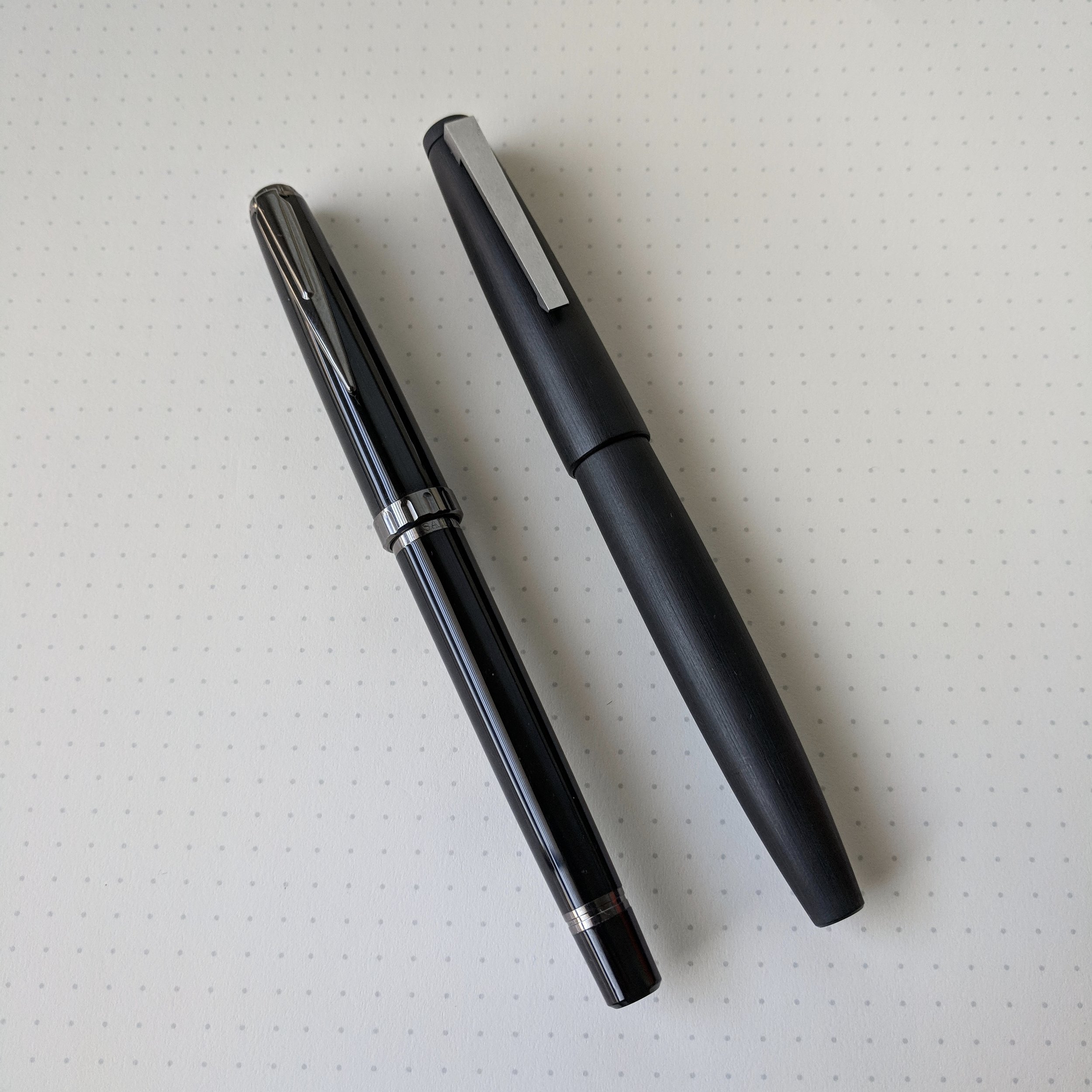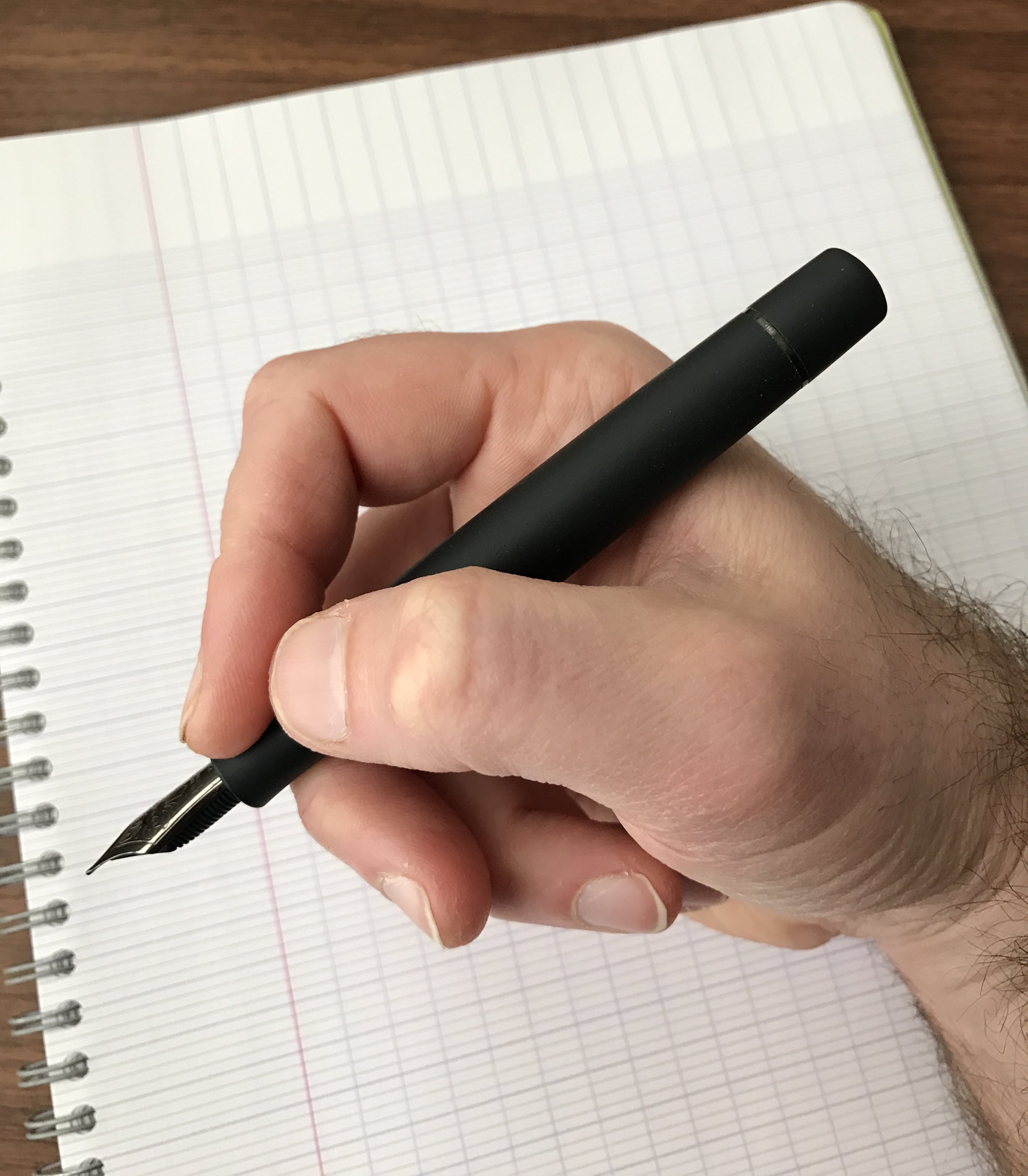For the first several years I participated seriously in this hobby (through the early-to-mid 2010s, it seemed as though pen companies were racing to introduce a “stealth” version of their various models, typically a black or matte black version of a pen featuring black-plated trim. (I’ve actually been around long enough to recall Pilot’s release of the current matte-black Vanishing Point, as well as a series of other VPs with matte-black trim and accents.) I’ve always wondered what makes these particular pens so popular. Black-on-black pens, and especially matte black pens, show no sign of going away anytime soon, so this week I spent some time noodling on it and felt compelled to put together an “all-black” carry for yesterday’s remote work outing.
From left, the Sailor 1911 “Black Luster” edition, my own T.G.S. x Sunderland mk1 rollerball, and the Montblanc “Midnight Black” Starwalker Rollerball. Case is a special edition Nock Co. Sinclair (since discontinued).
Originally, “stealth pen” marketing borrowed heavily from the “tactical pen” crowd, evoking military imagery, extreme durability, and touting the ability to bring your fountain pen along on those top-secret night missions. For example, I recall Monteverde marketing a pen with Goulet called the “Nighthawk” that featured black trim and a carbon fiber motif. Over the years, however, blacked-out pens and black trim in general became mainstream, not just a sub-category targeted to EDC (“everyday carry”) enthusiasts.
Contrary to popular belief, black pens don’t have to be boring. Not only can you add a splash of color to really set off the finish, but manufacturers can vary the design on things like the grip section to add a lot of character. Check out the knurling on the Montblanc Starwalker!
I’m not sure the popularity of black-on-black pens should come as a surprise. Black accessories of any sort are universally appreciated because they match easily, and while some might be hesitant to claim “black” as their favorite color, I’d venture that it has much wider appeal than the stereotypical “stealth pen” customer would suggest. Here are a few key reasons why I enjoy them myself:
Sleek, Understated Look. In my “real” life as a working attorney, there are contexts in which I need a pen to blend in to the surroundings and not become a distraction. Court hearings, depositions, and crowded meetings are NOT the time to break out the bright red Pilot Custom Urushi, or the Krusac Scrimshaw Navigator. On the other hand, a black makrolon Lamy 2000, Lamy Studio LX All-Black, or Sailor Pro Gear Imperial Black doesn’t obviously turn heads at first glance (and most people won’t notice the Lamy 2000 isn’t a rollerball). In a culture where, unfortunately, many consider using any sort of decent pen or pencil to be a pretentious affectation, black pens can be a good choice where you feel as though you need to fly under the radar.
Better Grip and Texture. My favorite pens are what I call my “workhorses,” or pens that I can write with all day. Matte-finish pens offer a pleasant grip and texture for all-day writing sessions or when you’re in a hot room with sweaty hands. The pen won’t get slick.
Black Pens Age Well. As I’ll further discuss below, most black pens, and especially matte black pens, will eventually show some wear and tear. Personally, I find that it adds to the aesthetic and I will never replace a pen for this reason. Look no further than my Sailor Pro Gear Imperial Black, which not only has worn smooth and shiny on the barrel from years of regular use, but now has a partially chrome (as opposed to black-plated) cap finial. I have experienced zero wear, however, on the black ion plating to the nib, clip, or cap band.
Some flaking on the cap finial is actually the only real wear and tear on my eight-year-old Sailor Imperial Black Fountain pen, which I re-reviewed years after I first purchased the pen.
Eight years and one dropped nib repair later, the nib on my Sailor Imperial Black looks just as good as it did when I first purchased this pen! Thanks Mark!
Of course, there are also some considerations that anyone considering a matte black pen - especially one with black trim - should keep in mind. First, if you’re particular about scratches, chipping, and visible wear on your pens, this finish may not be for you. Most matte texture is created using some form of powder-coating or anodization, and no matter how careful you are with your pens, the finish will eventually wear smooth, and you will likely accumulate some dings and scratches. As I noted above, I love how this looks over time, and merely serves as a reminder that my pens are tools meant to be used, but hey, personal preference. Second, if you are considering a pen with a plated or coated nib, talk to an experienced nib grinder before performing any sort of modification on the pen. Different manufacturers use different techniques to plate their nibs, and depending on the quality of the work and materials used, the coating can start to peel or flake off if the nib is ground. That’s not to say you can’t do it, but I’ve experienced it on a few pens across multiple brands and price points. (You can’t blame the manufacturers for this. When you choose to grind a nib, you are, after all, modifying their pen in a way that they did not originally intend. You are responsible for educating yourself on all the different things that might occur as a result.)
You know that you’ve really gone off the deep end when you find yourself purchasing things like these matte black Allex scissors, not necessarily because you have a burning use case for them, but because C.W. Pencil Enterprise is closing and, well, you just need these for your desk. (Great scissors, btw.)
While there have been murmurs in the pen blogosphere about blacked-out pens being “tired” or “played out,” I expect them to continue to sell well, and for manufacturers to continue to make these pens for as long as demand holds up. Personally, I consider this a classic design, and would love to see black trim in particular become a default option alongside the black/gold and black/rhodium that you see everywhere. I can’t help but think it might even outperform the current “standards.” Consider some other possibilities. I mean, Lamy recently released a brown Lamy 2000 with a brown plated clip. If they released a version of the 2000 with a ruthenium-plated clip, section, and nib, can you imagine how well that would sell?
(Maybe terribly, but I don’t care. I still want it.)
You can’t accuse me of inconsistency. I’ve always loved a matte-black pen with a dark red section. Here, the visibility isn’t the best because the alumilite has darkened over the years, but my Newton Shinobi is black ebonite with a dark, blood red alumilite section.
Ending with a Shameless Plug for the T.G.S. x Sunderland Machine Works MK1
Since I love black pens, it’s not a coincidence that I chose to incorporate a matte black finish into the first exclusive pen collaboration that I’ve done: the T.G.S. x Sunderland Machine Works mk1 matte-black and burgundy release. While you can read more on the specs for this pen in the shop listing, this release pairs the comfortable and functional Sunderland mk1 design with a durable bead-blasted matte-black and burgundy finish, along with a DLC (Diamond-Like-Coating) black stainless steel clip. I need to give Sunderland mad props for the durability of the finish on this pen - as I noted above, most matte pens will show wear over time, especially if you toss it into bags, pen cases, and pockets. After more than seven months of hard use, however, my current demo shows no wear, which can only be a testament to the quality of the processes used. (Note: I’ve intentionally NOT been gentle with this pen, since I wanted to see how it would hold up in the real world.)
Yes - the section threads are internal, so they don’t interfere with your grip.
I’d love to do more pen collaborations in the future, and given how well this one has sold, you can expect more from me in the coming year. The T.G.S. x Sunderland pen is not a limited edition, but it is a store exclusive, so you can only get it directly from the T.G.S. Curated Shop. Priced at $110, it’s a slight premium over the standard Sunderland mk1, mainly due to the cost of the bead-blasted finish and DLC coating. All proceeds go to support and grow T.G.S., both the blog and the fledgling shop operation!
This post does not contain paid third-party affiliate links. By shopping with us directly, you are supporting original content, pen reviews, pen show events, etc. from The Gentleman Stationer. If you would like to support us even further, please consider checking out the T.G.S. Patreon Program, which offers access to online meetups, exclusive discounts (including a slight price break on the Sunderland) pre-orders, and more!

